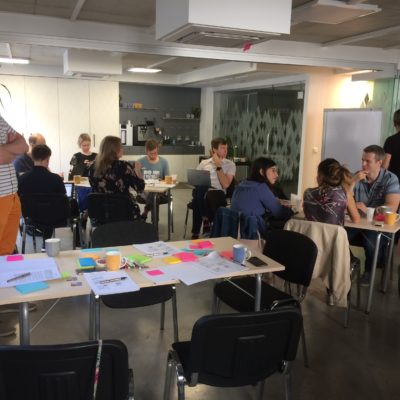Alistair Cockburn: „Agiilsus vajab eelkõige muutust mõttemaailmas.“

Alistair Cockburn ei vaja agiilsete arendusmetoodikate valdajate seas väga tutvustamist, olles üks „Agile manifesto“ kaasautoritest, tarkvaraarendaja, mitmete raamatute autor ning nõutud koolitaja üle maailma. BCS Koolitusel ja Devtrainingul oli hea meel võõrustada Alistair Cockburni Tallinnas, kus ta viis läbi kahepäevase koolituse product owneritele (7 Tools for the Product Owner). Saime võimaluse korraks koolitusklassi melust välja astuda ning vestelda Alistairile südamelähedastel teemadel.
Intervjuust saad teada:
- Millele keskenduda, kui aega on jäänud väheks, kuid kliendile tuleb peagi esitleda toote või teenuse kontseptsioon, idee?
- Milles on peamine probleem, miks projektid ebaõnnestuvad, isegi kui rakendatakse agiilset metoodikat?
- Kust saab Alistair inspiratsiooni luuletuste kirjutamiseks ning millal võib teda jälle Eestisse oodata?
Alljärgnev intervjuu on inglise keeles.
Q: There’s never enough time. Could you please give some hints or suggestions what to do in order to maximize the value to the customer when time is running out?
A: This is one of the things that we have covered very explicitly (during the training). Projects have multiple phases in the beginning. There are spikes, trials and tests to see if this project is going to be too expensive, the people who are hired are wrong or technology won’t work. That is blended in with the most important elements of the value to the customers or the users. Those are very carefully selected so that least important features, fine details on the features are added later. You work to get the basic building blocks, the most important things in place and if you run out of time you can at least survive with just that amount. This should be done ideally early and you can add in the features, handsomest of that thing to be nicer to use or more complete. And you are starting with acceptable but not wonderful system and you keep adding on to acceptable to make it nicer and nicer till you run out of time.
Q: What do you see is often the main problem why projects fail even if agile mindset, method have been used?
A: Most companies don’t do agile even if they say they do. It’s very easy to pick a few of the visible elements of the agile world, like the stand-ups, time boxes, sprint preview. But agile works because it relies on improved collaboration, communication and feedback. There’s a cultural shift where people have to be willing to talk to each other, find out things, collaborate and work on small problems together. So, the usual failure why people are not collaborating is that they have department boundaries, they do everything the same as before, but they just do the daily stand-up and that’s why there is no change. Agile really poses changes in culture such that people are willing to talk to each other, with some good intention to do an honest exchange. That’s the hardest thing for the organizations to adopt. You’ll often hear people they made the mechanics of agile, but they didn’t do the behavior or the attitude of agile. So agile is first the attitude change. When you have the attitude change and you want to discuss with people and you want to collaborate then you’ll go across the organizational boundaries and make those things. The visible parts help you to keep track on doing that. So, the hardest part of the agile is trying to notice or detect the difference in attitude.
Q: Could you say that in countries where people tend to be more introverts it is more difficult to use agile, for example we Estonians or Finns?
A: The Finns very strangely are a lot less introverted than 20 years ago. I think the cellphones and travelling has changed the Finnish character a lot. The Estonians I don’t know. Its not so much the introverts as they also can work together. But there are company and country culture that are hierarchical. So actually, Finland comes out very well because they are socially even. But there are other countries for example Mexico, Chile, even France, Asian countries where they are not allowed to talk to their bosses. They can’t give bad news to their bosses, can’t say they are having trouble and they can’t talk across the organizational boundaries. Those are more problematic issues than the introvert question.
Q: You write poems. Where do you get the inspiration, also from the classes like these?
A: I write poems about anything I see. I don’t write poems about me. One of my favorite poems is when I was watching somebody going off a ten-meter diving platform. I was trying to imagine the moment about one second after they go off when they are just starting to fall and are out of balance. I write funny poems about potatoes having sex, how potatoes reproduce, love poems made of lights, light and different colors and anything that crosses my mind. I learned that it’s very easy to make any event tragic and its hard to make happy poems.
Q: When will you come back to Tallinn, Estonia?
A: This is my third or fourth visit. I have been here with my family as well. I’ll be back, probably next year.
